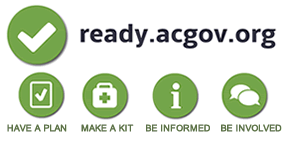Prepare for Winter Storms

WHAT IS PUBLIC WORKS DOING TO PREPARE FOR WINTER STORMS
Storm season begins in October and ends in March; however it is still possible to have heavy storms both before and after the storm season. The Alameda County Public Works Agency operates under the premise that a catastrophic weather front could impact Alameda County at any time and, therefore, consistently maintains elevated standards of preparation.
The Public Works Agency's Maintenance and Operations Department routinely provides the following preventive measures:
- Monitor and clear silt basins, storm drains, and flood channels
- Operate and maintain 24 pump stations throughout Alameda County
- Construct capital improvements to preserve or improve flood protection; and
- Inspect County dams located at Cull Canyon, Don Castro, and Ward Creek, for debris and proper functioning.
SANDBAG INFORMATION
Sandbag Locations for Residents of Unincorporated Alameda County Only
If you do not live in unincorporated Alameda County, Please contact your local jurisdiction (PDF - 292kb) for sandbag locations.
More Video Tips
BEFORE
Preparing For The Winter Storm Season
Preparing For A Pending Storm Event
How to Be Winter Storm Ready (PDF - 323kb)
Flood Preparedness and Storm Readiness (PDF - 395kb)
Detain the Rain Brochure (PDF - 323kb)
Emergency Preparedness Kits (PDF - 173kb)
AFTER
DEVELOP AN EMERGENCY PLAN
Visit www.ready.gov for assistance with personal family emergency plans.
Although flooding is rare in Alameda County, here are some ideas to help you and your family develop an emergency plan:
- Share contact information (home, business, school, day care) with your family and neighbor(s). Be sure your kids know who to call and how to dial 911 for emergency help. Also keep a designated contact out of state who can be reached by members of your family.
- Plan ahead: Where will you meet if you're separated? Do you have someone to stay with if you need to leave your home? What will you do with your pet?
- Pack an emergency kit and make sure every family member knows where it is located. Keep supplies in air-tight or water-proof bags. Keep a portable radio(s) or a hand-crank radio; an emergency supply of essential medicine, eye glasses or other vital support aids; cash, food, and batteries. If you need to leave, will you take important documents or valuables? If you have to evacuate, follow the instructions you are given. Tune your radio to KCBS 740 AM or KGO 810 for emergency instructions. If you cannot leave your home in a flood, move to the highest floor/level possible. Take dry warm clothes, flashlights, your radio, cell phone, a whistle - and your emergency kit.

HELPFUL LINKS
- Alameda County Flood Control & Water Conservation District
http://acfloodcontrol.org/ - Be Flood Ready
http://www.water.ca.gov/floodsafe/ca-flood-preparedness/fpw_home.cfm - California Nevada River Forecast Center
http://www.cnrfc.noaa.gov - CA.gov Be Storm Ready
http://storms.ca.gov - FEMA Flood Insurance
www.floodsmart.gov - National Weather Service, San Francisco Bay Region
http://www.wrh.noaa.gov/mtr/ - Preparing Personal Emergency Plans
www.ready.gov
